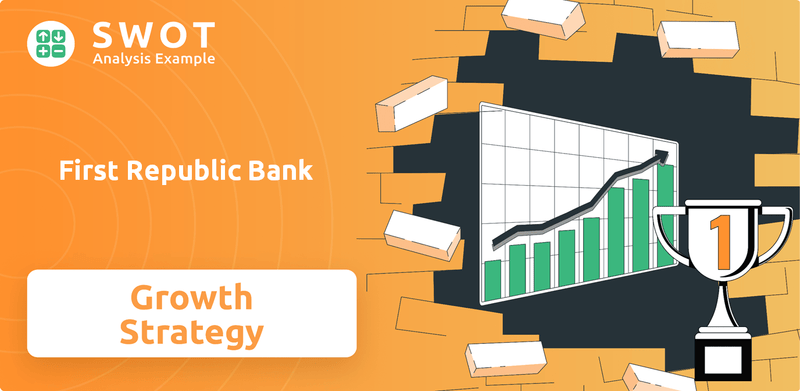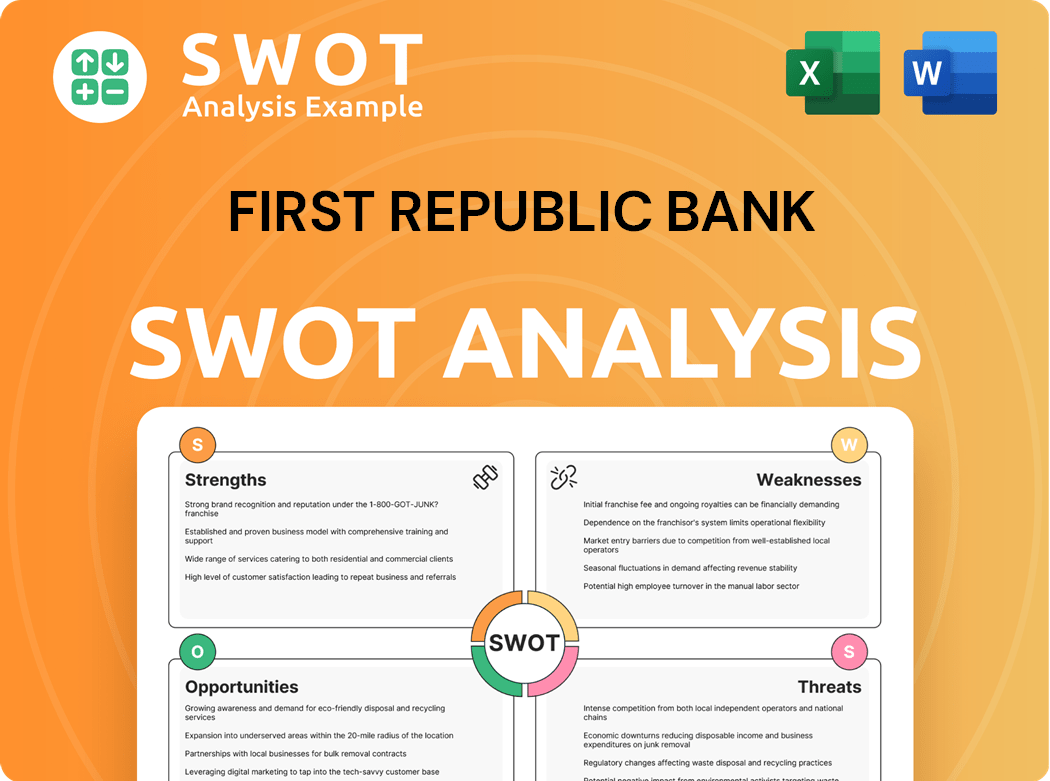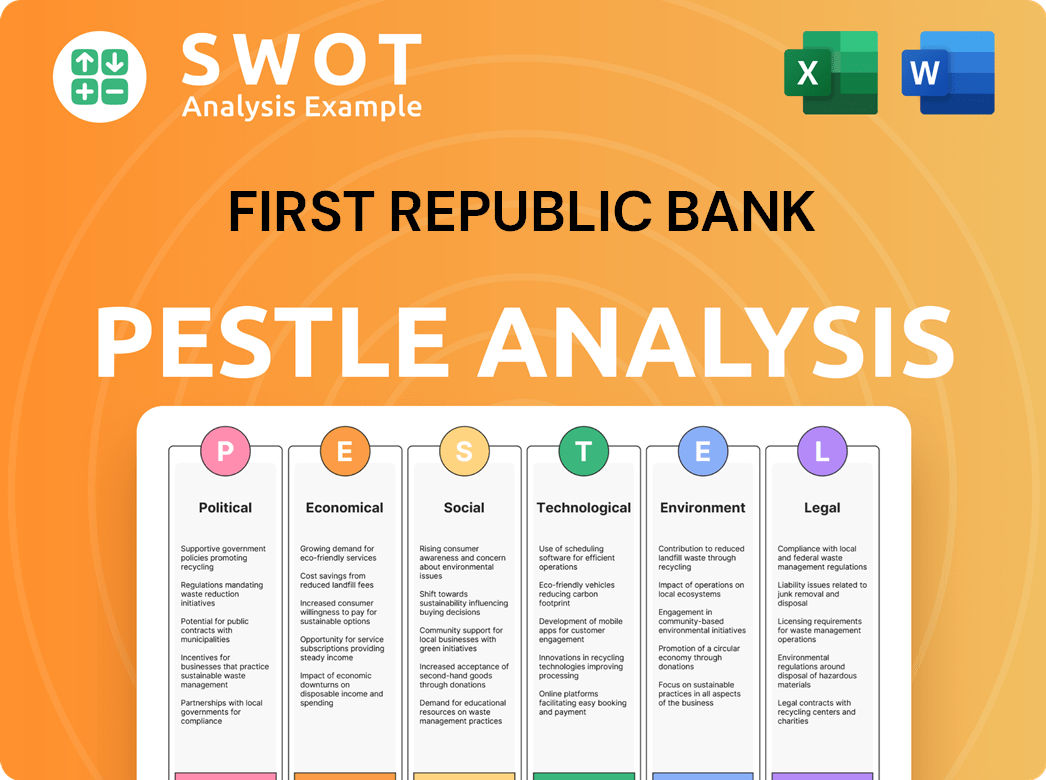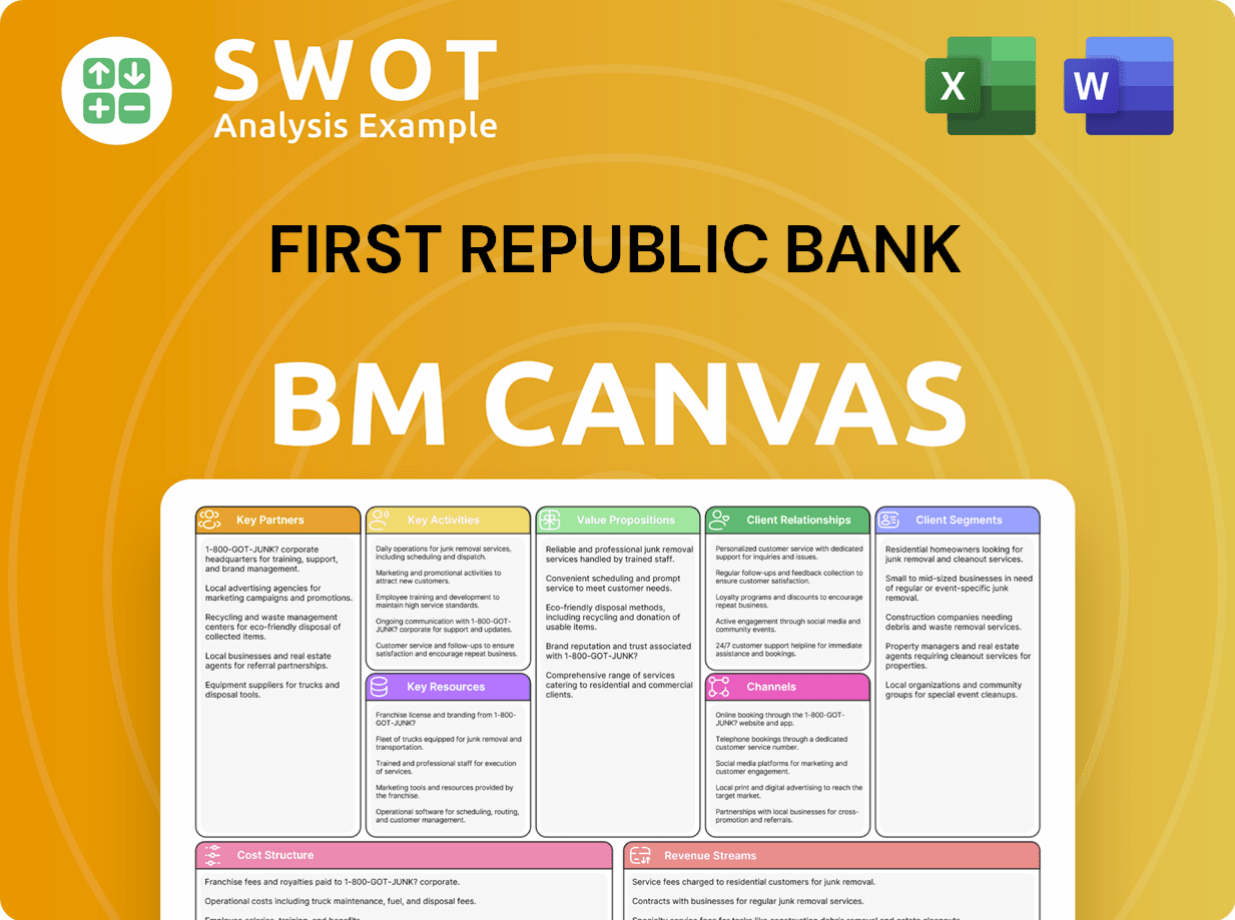First Republic Bank Bundle
Can JPMorgan Chase Revitalize First Republic Bank's Growth?
The acquisition of First Republic Bank by JPMorgan Chase in May 2023 reshaped the financial landscape, presenting both challenges and opportunities. This strategic move has significantly altered First Republic's First Republic Bank SWOT Analysis, impacting its future trajectory. Understanding the evolution of First Republic's business model and its integration into JPMorgan Chase is crucial for assessing its future prospects.

This analysis delves into the First Republic Bank Growth Strategy post-acquisition, examining its evolving market position and potential for expansion. We will explore the FRB Financial Performance indicators and the impact of this integration on the competitive landscape. Furthermore, we'll assess the long-term financial projections and investment opportunities, providing a comprehensive view of First Republic Bank's future outlook.
How Is First Republic Bank Expanding Its Reach?
Following the acquisition of First Republic Bank, JPMorgan Chase has initiated significant expansion initiatives to leverage the acquired assets and client base. The primary focus is on integrating and expanding wealth management services, particularly in affluent markets where First Republic had a strong presence. This strategic move aims to capitalize on the existing client relationships and branch network to grow the firm's wealth management segment.
The expansion strategy involves converting former First Republic branches into J.P. Morgan Financial Centers, designed to offer high-touch, concierge-level services. These centers cater to affluent clients, providing dedicated advisors and a comprehensive suite of wealth management solutions. The initiative is a key component of JPMorgan Chase's broader strategy to enhance its market position and capture a larger share of the high-net-worth client segment.
This strategy has shown early success, with a high retention rate of First Republic's clients and deposits. The integration of First Republic's service model into JPMorgan Chase's existing platform has also accelerated access to high-net-worth clients. The expansion is expected to continue, with more Financial Centers planned in the coming years to further solidify JPMorgan Chase's presence in key markets.
JPMorgan Chase is converting 84 former First Republic branches into J.P. Morgan Financial Centers. These centers are designed to offer specialized wealth management services. The expansion includes locations in affluent areas such as Napa, Palm Beach, and Manhattan.
The Financial Centers target affluent clients with over $750,000 in qualifying deposit and investment balances. These clients receive 'concierge-level service' from dedicated Senior Private Client Bankers and wealth management advisors. This focus allows for personalized financial solutions.
JPMorgan Chase plans to open more than 30 Financial Centers by the end of 2026. In 2024, 14 new centers were opened in high-growth markets like Florida and California. The company aims to nearly double this number by the end of 2025.
Approximately 90% of First Republic's banking clients have been retained. Over 95% of deposit balances were also retained, showing successful integration. This retention rate highlights the value of First Republic's service model.
JPMorgan's wealth management revenue has grown over 15% annually since 2023, reflecting the positive impact of the First Republic integration. The Asset and Wealth Management (AWM) business segment reported a 19% rise in assets under management (AUM) to $3.6 trillion in the first quarter of 2024. This growth was driven by higher market levels and strong net inflows, including $34 billion in long-term net inflows.
- Client asset net inflows for JPMorgan Chase totaled $486 billion in 2024.
- Cumulative net inflows over the past two years reached $976 billion.
- This demonstrates strong financial performance and successful integration.
- The expansion strategy is a key driver of the First Republic Bank Growth Strategy.
First Republic Bank SWOT Analysis
- Complete SWOT Breakdown
- Fully Customizable
- Editable in Excel & Word
- Professional Formatting
- Investor-Ready Format

How Does First Republic Bank Invest in Innovation?
Examining the innovation and technology strategy of JPMorgan Chase offers insights into how it is adapting in the financial sector. This strategy is critical for understanding the First Republic Bank Growth Strategy and its Future Prospects, particularly post-acquisition. JPMorgan's approach provides a benchmark for assessing the competitive landscape and potential First Republic Bank Analysis.
JPMorgan Chase's substantial investments in technology are aimed at driving growth through digital transformation, automation, and the integration of cutting-edge technologies. These initiatives are essential for maintaining a competitive edge and improving operational efficiency, which is crucial for FRB Financial Performance.
These technological advancements are crucial for understanding how the bank is positioned in the market and its overall First Republic Bank Market Position. The following sections detail JPMorgan's specific technology investments and their impact on its operations and customer service.
JPMorgan Chase plans to invest approximately $17 billion in technology in 2024. This significant investment underscores the bank's commitment to innovation and digital transformation.
The investments are primarily focused on digital transformation, automation, and the integration of technologies like AI. These areas are key to enhancing operational efficiency and improving customer experiences.
JPMorgan has launched an in-house generative AI tool, the LLM Suite, for over 200,000 colleagues. This tool is designed to provide real-time investment insights and enhance productivity.
The bank is modernizing its infrastructure, aiming to migrate approximately 95% of production applications in its Commercial & Investment Banking (CIB) and 99% in Asset & Wealth Management (AWM) divisions to strategic data centers and the public cloud by the end of 2024.
By the end of 2024, JPMorgan aims to have 70% of its applications and 75% of its data in public or private clouds. This migration is a key part of its digital transformation strategy.
JPMorgan has enhanced its digital tools, including the Wealth Plan platform, which had over 10 million users and created over one million personalized plans as of March 2024. This shows a strong focus on customer-centric innovation.
JPMorgan Chase's technology investments are designed to improve client services and achieve growth objectives. These initiatives are pivotal for understanding the bank's Business Model and its ability to adapt to changing market conditions. For further insights into the financial health and strategic direction of the bank, you can explore the perspectives of Owners & Shareholders of First Republic Bank.
- AI Integration: The LLM Suite is used to analyze vast datasets, providing real-time investment insights, and improving productivity.
- Cloud Migration: Migrating applications and data to the cloud enhances scalability, efficiency, and resilience.
- Digital Tools: Enhancements in digital platforms, such as the Wealth Plan, improve customer experience and engagement.
- Investment in Customer Experience: Increased investments in product, technology, and customer experience, totaling approximately $4 billion in 2024, accelerate innovation and AI readiness.
First Republic Bank PESTLE Analysis
- Covers All 6 PESTLE Categories
- No Research Needed – Save Hours of Work
- Built by Experts, Trusted by Consultants
- Instant Download, Ready to Use
- 100% Editable, Fully Customizable

What Is First Republic Bank’s Growth Forecast?
JPMorgan Chase's financial results for 2024 offer insights into the potential financial outlook following the acquisition of First Republic Bank. The firm's strong performance, including a record $54 billion in net income and a 12.3% increase in total net revenue to $177.6 billion, sets a positive backdrop. This growth was fueled by increases in both net interest income and noninterest revenue, indicating a robust and diversified revenue stream.
The Asset & Wealth Management (AWM) segment's impressive growth, with management fees up 21% and revenue reaching a record $5.8 billion in 2024, is particularly relevant. The AWM unit's assets under management reached $4.0 trillion, and client assets were $5.9 trillion, each up 18% in 2024. This growth suggests that the integration of First Republic Bank could benefit from the existing strong performance of the AWM segment.
The acquisition of First Republic Bank is projected to be modestly accretive to earnings per share, generating over $500 million in incremental net income annually, excluding one-time gains and restructuring costs. This suggests that the integration is already yielding positive financial results. The bank's wealth management revenue growth of over 15% annually since 2023 further supports this positive outlook. For a deeper dive, explore the Marketing Strategy of First Republic Bank.
JPMorgan Chase's total net revenue reached $177.6 billion in 2024, a 12.3% increase from 2023. Net interest income rose to $92.6 billion, and noninterest revenue reached $85.0 billion. These figures highlight the strong financial foundation that supports the integration of First Republic Bank.
The AWM segment saw significant growth, with management fees up 21% and revenue reaching a record $5.8 billion in 2024. Client asset net inflows for AWM totaled $486 billion in 2024, contributing to cumulative net inflows of $976 billion over the past two years. This strong market position is expected to aid the integration of First Republic Bank.
The acquisition is expected to be modestly accretive to earnings per share and generate over $500 million of incremental net income per year. The CET1 capital ratio of 15.7% as of December 31, 2024, demonstrates a strong capital position. This solid business model supports sustainable growth.
Wealth management revenue has grown over 15% annually since 2023, indicating successful integration and growth strategies. The U.S. economy expanded by an estimated 2.8% in 2024, more than doubling initial estimates. These factors suggest a favorable environment for First Republic Bank's future prospects.
The outlook for 2025 anticipates easing global policy with falling interest rates and expanding economies. Accelerating capital investment is also expected. These conditions, combined with the successful integration of First Republic Bank, suggest a positive outlook.
- Modestly accretive to earnings per share.
- Over $500 million in incremental net income per year.
- Wealth management revenue growth of over 15% annually.
- CET1 capital ratio of 15.7% as of December 31, 2024.
First Republic Bank Business Model Canvas
- Complete 9-Block Business Model Canvas
- Effortlessly Communicate Your Business Strategy
- Investor-Ready BMC Format
- 100% Editable and Customizable
- Clear and Structured Layout

What Risks Could Slow First Republic Bank’s Growth?
The integration of First Republic Bank presents several challenges for JPMorgan Chase, potentially affecting its ambitious growth plans. The competitive landscape in wealth management and the banking sector's stringent regulatory environment add further layers of complexity. Successfully navigating these risks is crucial for realizing the First Republic Bank Growth Strategy and achieving its future prospects.
Market dynamics and economic factors, such as inflation and geopolitical instability, also pose significant threats. JPMorgan Chase must continually invest in technology and innovation to maintain a competitive edge while managing costs effectively. The firm's ability to adapt to these challenges will be vital for its long-term success and financial performance.
Regulatory changes and increased scrutiny are ongoing concerns in the banking industry, especially following recent bank failures. JPMorgan Chase's CEO Jamie Dimon has emphasized the need for transparent, fair, and holistic regulations that balance economic growth and a safe banking system. The firm also faces the challenge of continually investing in technology and innovation to stay competitive while managing costs. While JPMorgan plans to spend $17 billion on technology in 2024, a significant portion is dedicated to modernization and AI readiness, highlighting the ongoing financial commitment required.
The wealth management sector is highly competitive, with numerous firms vying for high-net-worth clients. This competition can impact the First Republic Bank Market Position, as attracting and retaining clients becomes more challenging.
The acquisition of First Republic Bank involved integrating its operations and workforce into JPMorgan Chase. Some advisor departures were observed during the initial integration period, indicating the difficulty of retaining talent during such transitions.
The banking industry faces ongoing regulatory changes and increased scrutiny, particularly after recent bank failures. JPMorgan Chase must navigate these evolving regulations to maintain compliance and ensure the safety and soundness of its operations.
Keeping pace with technological advancements requires significant investment. JPMorgan Chase plans to spend $17 billion on technology in 2024, a considerable financial commitment to modernization and AI readiness.
Broader economic factors, such as inflationary pressures and geopolitical instability, pose risks to JPMorgan Chase. Jamie Dimon noted in January 2025 that ongoing and future spending requirements could be inflationary, and geopolitical conditions remain dangerous and complicated.
JPMorgan Chase maintains a 'fortress balance sheet' to mitigate risks, with $547 billion of total loss-absorbing capacity and $1.4 trillion of cash and marketable securities. This provides a liquidity buffer to weather economic downturns.
The wealth management sector is intensely competitive, with numerous firms vying for high-net-worth clients. This competition could affect the First Republic Bank Business Model, potentially impacting its ability to attract and retain clients. JPMorgan Chase needs to differentiate itself to maintain its market position and achieve its growth targets.
Integrating First Republic Bank involves merging its operations and workforce into JPMorgan Chase. The initial period following the acquisition saw some advisor departures, indicating the complexities of retaining talent during such integrations. Successfully integrating First Republic Bank is crucial for realizing its full potential.
The banking industry faces ongoing regulatory changes and increased scrutiny. JPMorgan Chase must navigate evolving regulations to maintain compliance and ensure the safety and soundness of its operations. This requires constant attention and investment in compliance measures.
Broader economic factors, such as inflationary pressures and geopolitical instability, pose risks. Jamie Dimon noted that ongoing and future spending requirements could be inflationary, and geopolitical conditions remain dangerous and complicated. JPMorgan Chase must be prepared to navigate these challenges.
First Republic Bank Porter's Five Forces Analysis
- Covers All 5 Competitive Forces in Detail
- Structured for Consultants, Students, and Founders
- 100% Editable in Microsoft Word & Excel
- Instant Digital Download – Use Immediately
- Compatible with Mac & PC – Fully Unlocked

Related Blogs
- What are Mission Vision & Core Values of First Republic Bank Company?
- What is Competitive Landscape of First Republic Bank Company?
- How Does First Republic Bank Company Work?
- What is Sales and Marketing Strategy of First Republic Bank Company?
- What is Brief History of First Republic Bank Company?
- Who Owns First Republic Bank Company?
- What is Customer Demographics and Target Market of First Republic Bank Company?
Disclaimer
All information, articles, and product details provided on this website are for general informational and educational purposes only. We do not claim any ownership over, nor do we intend to infringe upon, any trademarks, copyrights, logos, brand names, or other intellectual property mentioned or depicted on this site. Such intellectual property remains the property of its respective owners, and any references here are made solely for identification or informational purposes, without implying any affiliation, endorsement, or partnership.
We make no representations or warranties, express or implied, regarding the accuracy, completeness, or suitability of any content or products presented. Nothing on this website should be construed as legal, tax, investment, financial, medical, or other professional advice. In addition, no part of this site—including articles or product references—constitutes a solicitation, recommendation, endorsement, advertisement, or offer to buy or sell any securities, franchises, or other financial instruments, particularly in jurisdictions where such activity would be unlawful.
All content is of a general nature and may not address the specific circumstances of any individual or entity. It is not a substitute for professional advice or services. Any actions you take based on the information provided here are strictly at your own risk. You accept full responsibility for any decisions or outcomes arising from your use of this website and agree to release us from any liability in connection with your use of, or reliance upon, the content or products found herein.